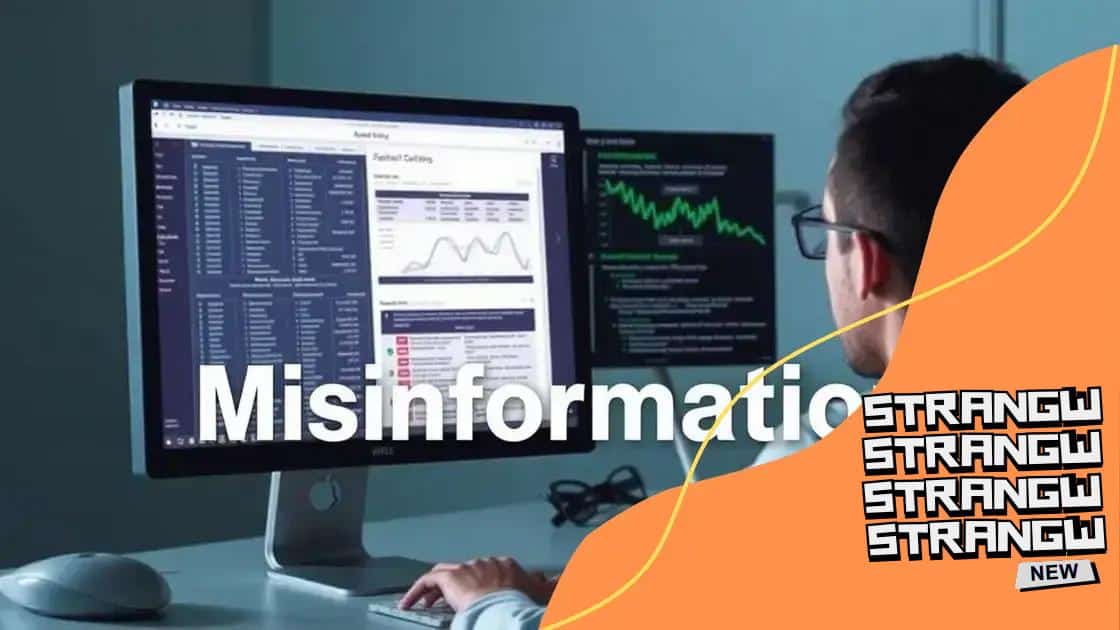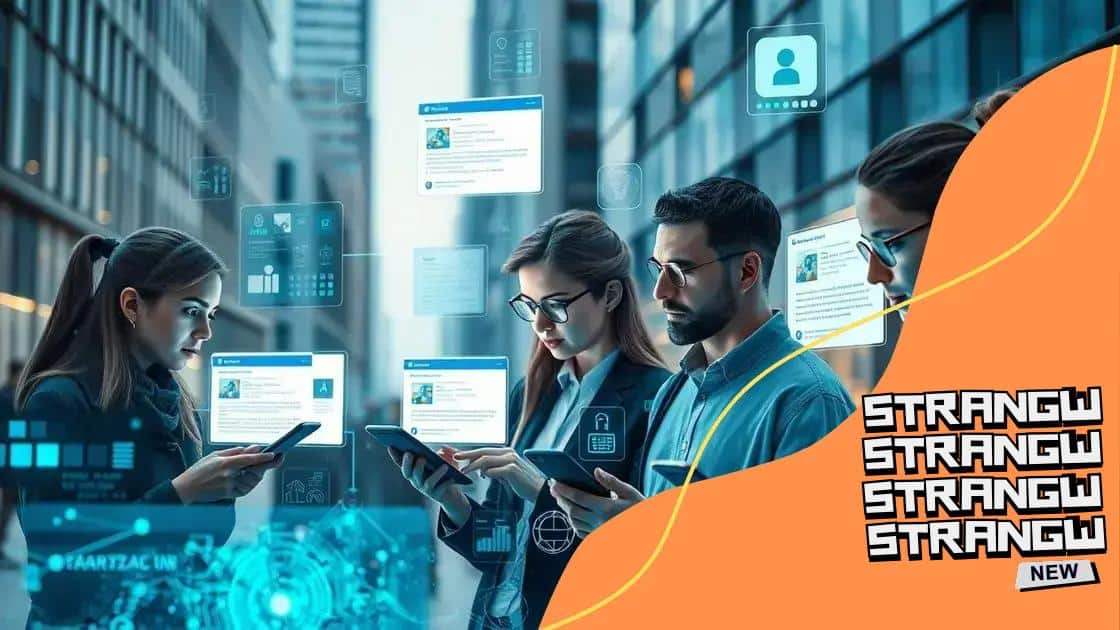AI-driven solutions for misinformation detection

AI-driven solutions for misinformation detection utilize advanced algorithms to analyze data rapidly, enhancing the accuracy and speed of identifying false information across various platforms.
AI-driven solutions for misinformation detection are becoming essential as false information spreads rapidly online. Have you ever wondered how these solutions work? Let’s dive into this pressing issue.
Understanding misinformation and its impact
Misinformation can significantly affect our understanding of current events. It is crucial to analyze and recognize its impact on society. Today, we’ll explore the various aspects of misinformation and how it shapes our perceptions.
What is misinformation? Misinformation refers to information that is false or misleading, often spread unintentionally. This can occur through rumors, social media posts, and even news articles. Most people might not realize when they share a piece of misinformation, which can easily lead to confusion.
Types of misinformation
Misinformation can take many forms. Here are some common types that we encounter:
- False news: Articles that are entirely fabricated.
- Misleading headlines: Headlines that don’t match the content.
- Outdated information: Information that was once true but is no longer valid.
- Exaggerations: Facts that are stretched beyond their truth.
Each type has a unique effect on the audience, causing misunderstanding or even panic. For instance, false news can lead to widespread fear, while outdated information might misguide decision-making processes.
The consequences of misinformation
The consequences of spreading misinformation can be severe. From influencing public opinion to affecting political decisions, the ripple effect can be vast. The impact can be most observed during events such as elections or health crises, where misinformation spreads rapidly, creating chaos.
Moreover, misinformation can erode trust in legitimate sources of information. When people continually encounter falsehoods, they may become skeptical of all news. This skepticism can undermine democratic processes and cause societal divisions.
It is essential to recognize the powerful role misinformation plays in shaping our views and behaviors. By doing so, we can better arm ourselves against its effects. Critical thinking and fact-checking are crucial in this battle against false narratives.
Ultimately, understanding misinformation and its impact is the first step toward fostering a more informed public. Awareness and education can empower individuals to discern truth from falsehood, leading to a healthier information ecosystem.
How AI analyzes and detects false information
Artificial intelligence (AI) is revolutionizing the way we approach misinformation. By utilizing advanced algorithms, AI analyzes vast amounts of data to detect false information quickly and efficiently. This process is crucial in today’s digital age, where misinformation can spread like wildfire.
Understanding AI’s methodology is essential. AI techniques often involve machine learning, natural language processing, and data mining. These technologies help in identifying specific patterns in data that indicate misinformation. For example, AI can scan social media posts and news articles to check for inconsistencies or suspicious sources.
Machine learning in misinformation detection
Machine learning is at the core of many AI systems. It works by training algorithms with large sets of data. When these systems are exposed to examples of true and false information, they learn to differentiate between the two. As they process more data, their accuracy improves.
Some methods of machine learning include:
- Supervised learning: requires labeled data to train models.
- Unsupervised learning: identifies patterns without labeled data.
- Deep learning: uses neural networks to analyze complex data sets.
Each of these techniques aids AI in spotting fake news. For instance, if an AI model frequently encounters misinformation from specific websites, it learns to flag similar content in the future.
Natural language processing (NLP)
For instance, if an article uses excessive sensational language, it might be more likely to contain misinformation. By identifying these red flags, AI can alert users to check the authenticity of the information.
As AI tools become more sophisticated, their capability to identify misinformation is improving. Users can leverage AI-driven solutions to verify facts before sharing or acting on them. This is becoming increasingly important as misinformation poses serious threats to public understanding.
In conclusion, AI’s ability to detect false information through advanced analytics, machine learning, and natural language processing is transforming the fight against misinformation.
Real-world examples of AI in misinformation detection

Artificial intelligence (AI) is actively being used in various real-world applications to combat misinformation. These implementations showcase the technology’s capabilities and its critical role in today’s information landscape. Let’s explore some notable examples.
One prominent example is the use of AI by social media platforms to detect and manage false information. Companies like Facebook and Twitter have integrated AI algorithms to identify misleading posts. These algorithms analyze user interactions and content patterns to flag potential misinformation. When AI detects suspicious activity, it prompts human reviewers for further evaluation.
Fact-checking partnerships
Many organizations have formed partnerships with fact-checking groups, using AI tools to enhance accuracy. AI helps in scanning large volumes of information quickly. By cross-referencing claims against credible sources, these systems can alert users to potential inaccuracies.
Some key partnerships include:
- Google and fact-checkers: Google News uses AI to highlight fact-checked articles alongside search results.
- YouTube’s misinformation filters: YouTube employs AI to suggest authoritative sources when users search for contentious topics.
- Facebook’s third-party fact-checkers: Facebook collaborates with independent organizations that verify the veracity of posts flagged by AI.
These collaborations help curtail the spread of false information and promote reliable content.
AI-powered verification tools
Another significant development is: the emergence of AI-powered verification tools. These tools assist journalists and content creators in assessing the authenticity of information before publishing. AI analyzes metadata, image sources, and even linguistic patterns to determine credibility. Examples include:
- Checkology: A platform designed to educate students about misinformation detection.
- TinEye: An image recognition tool that helps verify the authenticity of images by tracing their origins.
- Hoaxy: A tool that visualizes how misinformation spreads across social media.
These tools empower users to make informed decisions and verify information independently. By harnessing the power of AI, individuals can better navigate the complex world of online content.
In summary, the application of AI in real-world scenarios is proving invaluable in the fight against misinformation. From social media platforms to fact-checking organizations, AI is enhancing accuracy and fostering trust in information dissemination. As these technologies evolve, they promise to further improve our ability to identify and combat misinformation.
Benefits of AI-driven solutions for news verification
AI-driven solutions for news verification offer numerous advantages in today’s rapidly evolving information landscape. By implementing these technologies, organizations can improve the accuracy and reliability of news content. Let’s delve into some key benefits.
One of the most significant advantages is speed. AI can analyze vast quantities of data in real-time, significantly faster than human reviewers. This capability means that potential misinformation can be flagged and addressed before it spreads widely. For instance, if a breaking news event occurs, AI systems can quickly verify information from trusted sources.
Improved accuracy
Another benefit is enhanced accuracy. AI technologies utilize algorithms based on machine learning to learn from vast data sets. This enables them to identify patterns typical of false information. Over time, these systems become better at distinguishing fact from fiction. The accuracy gained from AI tools leads to more reliable news reports.
Moreover, AI can cross-check claims against credible sources quickly. By doing this, it significantly reduces the chances of accepting false information as valid.
Cost efficiency
Utilizing AI-driven solutions can also be cost-effective for news organizations. Automating the verification process streamlines operations, allowing human staff to focus on more complex tasks. This not only reduces the need for extensive personnel but also minimizes overtime costs associated with manual verification.
Enhanced efficiency can lead to:
- Faster news cycles: Stories can be verified and published more quickly.
- Resource allocation: Staff can focus on investigative journalism and deep reporting.
- Lower operational costs: Reduced need for manual checks saves money.
AI-driven solutions also benefit users by presenting them with accurate information. As readers gain access to verified news, their trust in media sources increases. This surge in trust can lead to higher engagement from audiences, fostering a well-informed public.
Furthermore, these technologies can adapt to emerging misinformation trends. By continuously learning from new data, AI systems stay relevant and effective. They are equipped to recognize and counter various tactics used by those spreading misinformation.
In summary, the benefits of AI-driven solutions for news verification are substantial. With their speed, accuracy, and cost efficiency, these tools are transforming the landscape of information sharing, ensuring a more informed society.
Future trends in AI and misinformation management
The future of AI in managing misinformation looks promising. As technology evolves, we can expect advancements that significantly enhance how we detect and combat false information. Understanding these trends can help us prepare for a world where information integrity is prioritized.
One key trend is the development of more sophisticated algorithms. Future AI models will better understand context, nuance, and the subtleties of language. This means they will be better equipped to detect misinformation in various forms, including deepfakes and misleading videos. As AI improves its understanding of social cues and emotional tones, its effectiveness in identifying questionable content will rise.
Integration of AI and human oversight
Another emerging trend is the growing synergy between AI and human fact-checkers. While AI can quickly scan vast amounts of information, human insight remains irreplaceable. In the future, automated systems will likely flag suspicious content, prompting human experts to conduct thorough evaluations.
This collaboration can lead to:
- Faster response times: Immediate alerts to potential misinformation.
- Better accuracy: Human review can catch what AI might miss.
- Increased trust: Consumers will gain confidence in verified information.
As this partnership evolves, organizations will be able to ensure accuracy and reliability in news reporting.
Personalization of information verification
Furthermore, personalization will become a critical component of misinformation management. Future AI systems may tailor news verification processes to individual users, considering factors like their interests and previous news consumption. By providing personalized fact-checking and news filtering, AI can help users navigate an information landscape tailored to their needs.
This customized approach can reduce the risk of users falling prey to misinformation by presenting them with vetted content relevant to their preferences. As people become more aware of how information impacts their beliefs, personalized verification will play an essential role in shaping understanding.
Finally, education will become a pivotal aspect of the future landscape. As AI tools become more mainstream, educational institutions will likely incorporate training on recognizing misinformation and using AI-driven solutions. Teaching people how to use these tools will empower them to assess information critically.
Ultimately, the trends in AI and misinformation management point toward a future where technology works hand in hand with human judgment. As we embrace these advancements, we can look forward to a more informed public and a healthier information ecosystem.
FAQ – Frequently Asked Questions about AI-driven Solutions for Misinformation Detection
How does AI help in detecting misinformation?
AI quickly analyzes vast amounts of data to identify patterns indicative of false information, making it faster than human verification.
What are some real-world applications of AI in combating misinformation?
AI is used by social media platforms for flagging questionable content, collaborating with fact-checking organizations, and developing verification tools.
Can AI replace human fact-checkers entirely?
No, while AI enhances efficiency, human oversight is crucial for context and nuance that AI might miss.
How can I benefit from using AI verification tools?
AI verification tools help ensure the accuracy of information, saving time and resources while increasing trust in content.





